Samsung Galaxy S8 Showdown: Exynos 8895 vs. Snapdragon 835, Performance & Battery Life Tested
by Matt Humrick on July 28, 2017 8:00 AM EST- Posted in
- Smartphones
- Samsung
- Galaxy
- Mobile
- SoCs
- Snapdragon 835
- Exynos 8895
- Galaxy S8
Battery Life
When Samsung introduced the Galaxy S7 last year, we were happy to see a larger 3000 mAh (11.55 Wh) battery inside, a significant increase over the 2550 mAh (9.81 Wh) unit inside the Galaxy S6. There is no further capacity increase this year, however. The S8 retains the same 3000 mAh (11.55 Wh) battery, which is the same capacity found in the HTC U11. The LG G6, perhaps the S8’s closest competitor, comes with a larger 3300 mAh (12.54 Wh) unit, which could help keep it running a little longer.
To see how Samsung’s two SoC choices affect the S8’s battery life, and see how it stacks up to its competitors, we’ll run it through our standard suite of battery tests. To make the tests accurate and repeatable, we control as many variables as possible, including minimizing background tasks and calibrating each display to 200 nits at 100% APL. All of the Android phones in the charts below except for the S7 (E8890) have all available software updates applied and are running the same version of Chrome.
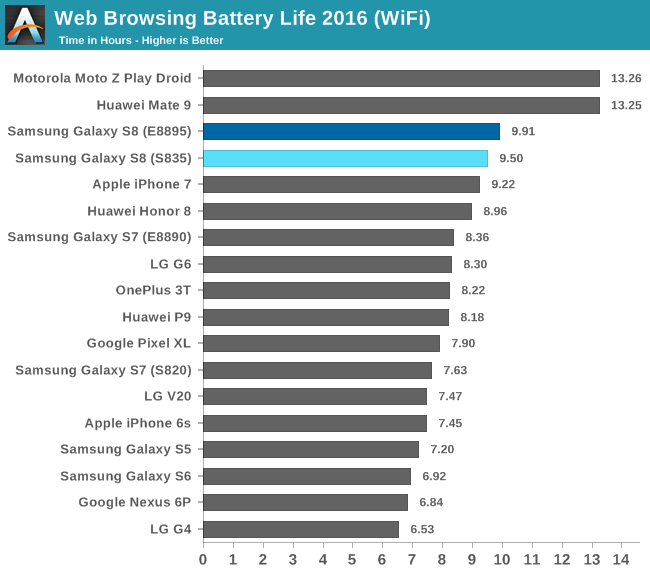
The Galaxy S8 does quite well in our Wi-Fi browsing test that loads, pauses, and then scrolls through a set of popular websites while connected to Wi-Fi with the cellular radio turned off. We do not see much difference in runtime (only 25 minutes or 4%) between the E8895 version and the S835 version here, mainly because this workload does not utilize the big CPU cores that much, and the display tends to be the greatest power consumer in this scenario. Shutting down just shy of the 10 hour mark, the S8 outlasts the iPhone 7 by either 17 or 41 minutes, a noteworthy accomplishment considering the S8 uses a larger AMOLED display that needs to cope with relatively high APL web content (lots of white backgrounds). The S8 (S835) also lasts nearly 1.25 hours longer than the LG G6 (S821), despite the latter phone having a bigger battery.
Of the two Exynos powered Galaxies, the E8895 S8 lasts 1.5 hours longer than the E8890 S7. The E8890 is hardly the most power efficient SoC, so this likely accounts for some but not all of the difference. The gap between the Snapdragon Galaxies is even bigger, with the S835 S8 browsing for 1.9 hours longer than the S820 S7.
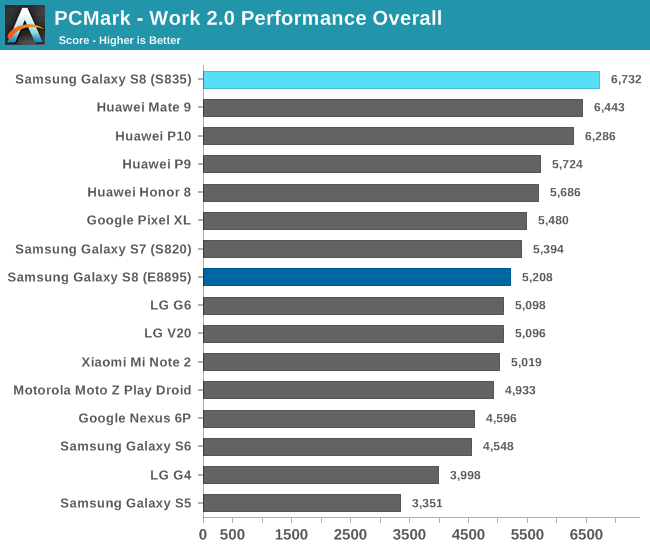

PCMark’s mixed workloads exercise the CPU, GPU, storage, and memory subsystems, giving us a more complete evaluation of battery life. Huawei’s Mate 9 runs longer than the S8 because of its larger 4000 mAh battery, but the S8 actually does quite well, with no appreciable difference in runtime between the two S8 models. Unfortunately, I was not able to take accurate power measurements, so we can only use average platform power consumption over the duration of the test for comparison, but the S8, regardless of SoC choice, uses considerably less power than the S5, S6, or S7 (S820). After factoring in overall PCMark performance, the S8 (S835) has the highest average efficiency of any device in this chart—about 24% better than the S8 (E8895). In the Wi-Fi Web browsing test, we saw very little difference between the two SoCs under a relatively light CPU load. The S8 (S835) manages to distinguish itself in PCMark primarily because of its more efficient GPU (Photo/Video Editing tests), which did not factor into the Wi-Fi browsing results. While not as efficient as the S835 version or the Mate 9 and its Kirin 960 SoC, the S8 (E8895) is still better than the LG G6 and the older Galaxy phones.
The S8’s settings menu offers a choice between several preset performance modes that affect sound quality, screen brightness, and screen resolution, among other things. For the results shown in the charts above, the S8s used the default “Optimized” setting that reduces the screen resolution to FHD+ (2220x1080). Running the PCMark battery test at its highest WQHD+ (2960x1440) setting has no appreciable affect on battery life, however, regardless of SoC.


Note: Both Galaxy S8 models use the default FHD+ (2220x1080) resolution setting in this test
In the GFXBench Manhattan 3.1 battery life test, which predicts runtime while playing games, there’s a significant disparity between the S8’s two SoCs. The S835 S8 lasts about an hour longer than the E8895 S8, even though both deliver nearly identical steady-state performance during most of the test. Using the average platform power to calculate efficiency (performance per watt) after the two phones reach steady-state shows the S835 S8 with a 39% advantage over the E8895 S8. Our E8895 example does seem to have a poor bin for both the CPU and GPU, an issue that seems fairly common with the early batch of 10nm SoCs, which likely skews the results somewhat, but it cannot account for this large of a gap.
This is the second SoC example we’ve seen using ARM’s Mali-G71 GPU—the first being HiSilicon’s Kirin 960—and performance per watt is disappointing for both in workloads that really stress the GPU. The GPU configurations are significantly different too: The Kirin 960 uses 8 cores running at up to 1037MHz on TSMC’s 16nm FFC process, while the Exynos 8895 uses 20 cores running at up to 546MHz on Samsung’s 10nm LPE process. Without more detailed data, this is just an interesting observation rather than a definitive statement about the G71’s or E8895’s power consumption.
While the E8895 S8’s battery life in this test falls within the 3-3.5 hour average for flagship phones, the S835 S8’s 4.1 hour mark is pretty impressive. It’s certainly not the longest lasting, but the phones that run longer deliver lower performance. For example, the S8 (S835) offers double the sustained performance of either S7 model while lasting 20 minutes longer. The Galaxy S6 outlasts the S8 (S835) by a slim margin but only because it throttles back performance so severely.
GPU Thermal Stability
The E8895 S8 achieves better peak performance than the S835 model initially, but begins to throttle back the GPU frequency just shy of 5 minutes to stay within its thermal limits. The S835 S8 maintains peak performance for about 13 minutes before throttling. Interestingly, both S8 models deliver the same performance after reaching steady-state 21 minutes into the test. The E8895 model consumes more power (and generates more heat) at the same performance level as the S835 model in this test, so it appears the E8895 S8 is using a higher thermal limit, although I was unable to confirm this in the short time I had with it.
Both Galaxy S8 models have higher sustained performance than other flagships. The Mate 9, for example, loses 38% of its peak performance after just 8 minutes, dropping to 21fps from 34fps, and remains at 19fps after about 30 minutes. The LG G6 starts at 16fps and begins throttling after 4 minutes before settling at 10fps after 13 minutes. The previous generation Galaxy S7 (S820) yields similar results to the G6: It starts at 16fps and starts throttling at the 13 minute mark, eventually settling at 8fps after 21 minutes.
Battery Charging
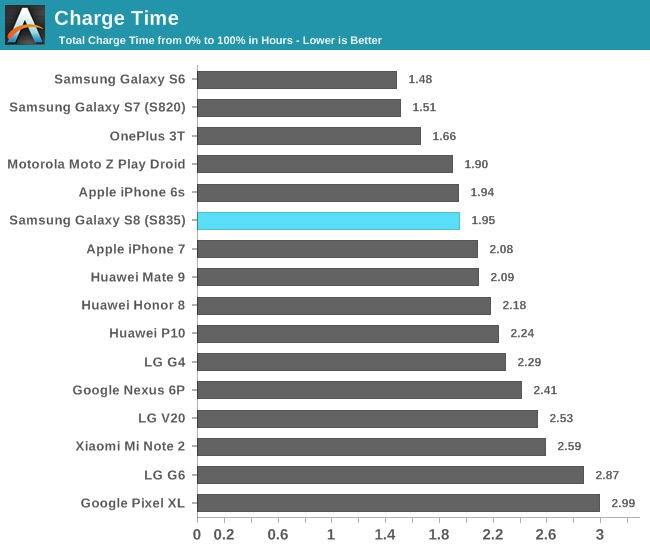
The Galaxy S8 comes with Samsung’s Adaptive Fast Charging technology along with both WPC and PMA wireless charging. Unlike some companies, such as Huawei and Motorola, that are pulling more than 20W of power at the battery, Samsung remains a bit more conservative. The included wall charger is rated for 5V/2A (10W) and 9V/1.67A (15W) operation—same as the Galaxy S7—which translates to a peak of 9.3W at the battery when charging with the screen off. Turning the screen on reduces the peak charging power to just 4.3W, so the S8 will not charge nearly as fast while you are using it.
The peak charging period lasts for 1 hour and 9 minutes before ramping down exponentially. This gets the S8 to 25% in 21 minutes and 50% in 42 minutes, very similar to the LG G6 and its almost 10% larger battery, which gets to 25% in 25 minutes and 50% in 46 minutes; however, the S8 is fully charged in just under 2 hours where the G6 takes 2 hours and 52 minutes. As another point of comparison, Huawei’s Mate 9, which has a much larger 4000 mAh battery, pulls up to 20.2W at the battery and reaches 25% capacity in about 12.5 minutes, 50% in about 25.5 minutes, and 100% in 2 hours and 5 minutes.


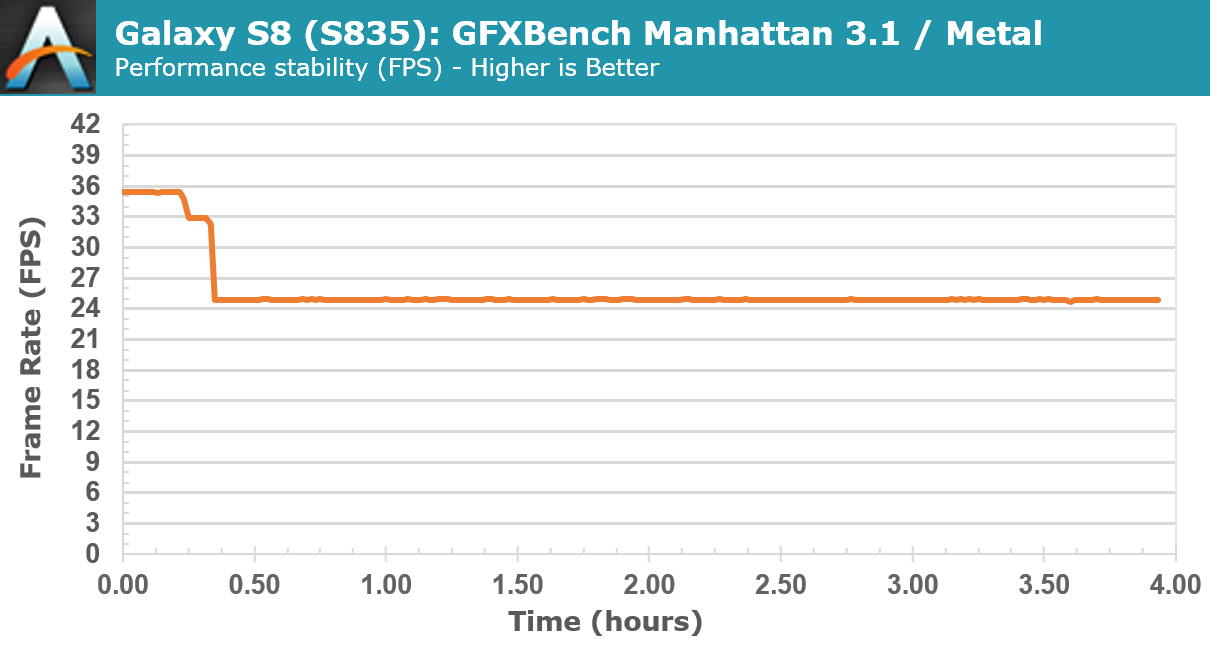
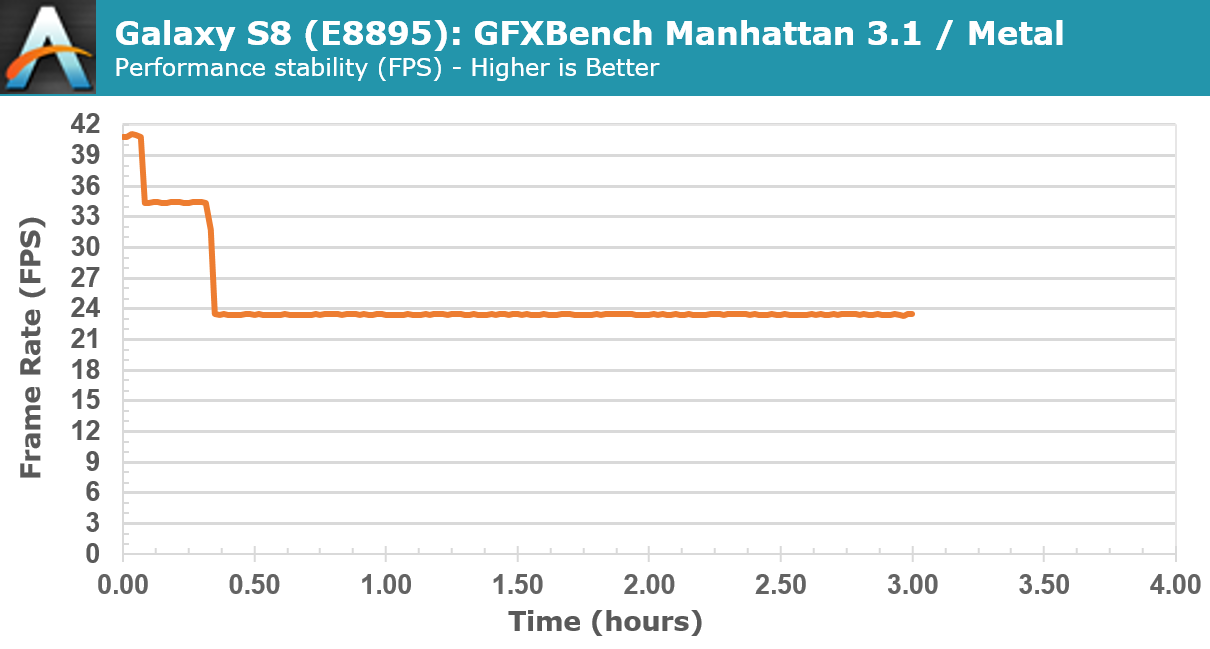
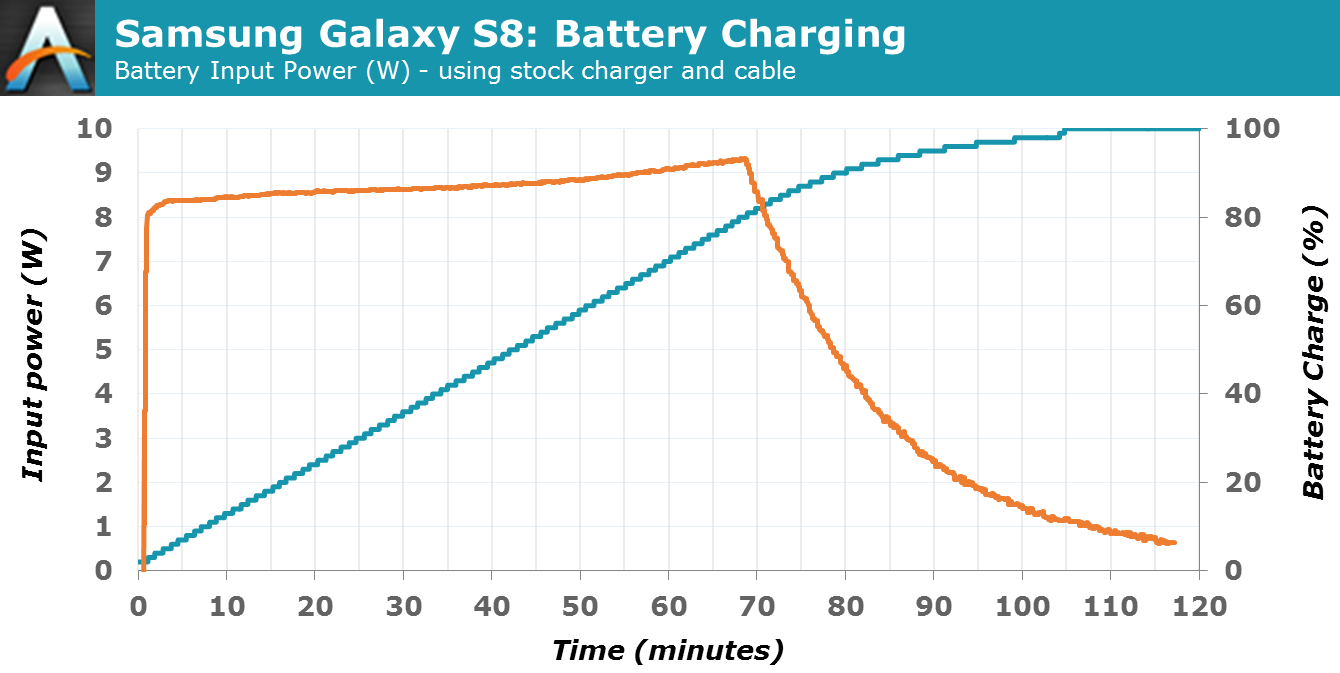








137 Comments
View All Comments
Nullify - Saturday, July 29, 2017 - link
Stupid video. Opening Apps means nothing.The better one is where they test loading large photos and applying effects in real time or rendering 4K video. iPhone 7 absolutely DESTROYS the OnePlus 5. And it's a year old phone on an older process while the 8895/835 are on 10nm.
Even funnier is watching you cry over on Ars when the iPhone 7 spanked every other phone in these App opening videos and you claimed the tests were flawed. Now that the OnePlus 5 opens Apps faster (marginally) suddenly these types of tests are valid? Hypocrite much?
Please stick around Anand. There are a lot of intelligent posters here who have a very good understanding of processor design (including the excellent staff here). I can't wait to hear the responses to your comments.
bigboxes - Saturday, July 29, 2017 - link
You fanboys are really something. Gotta protect your favorite company from the naysayers at all cost!Galid - Saturday, July 29, 2017 - link
I don't think you get it peeps, benchmarks here are sustained, opening apps is only using a small % of potential. When the apps/os starts to ask more, most of the android phones have the same problem, underclocking. Yep, it's easy to make a blazing fast processor but it's another feat to make it survive 100% load without underclocking.You might be able to put an 8 cylinder engine into a honda civic and use it to drive around town but push it a little bit too much and the car will suffer heavily. The frame won't support the torque.
Irish_adam - Saturday, July 29, 2017 - link
First of all your beloved iphone will also drop its clock rates after a couple of minutes because they are all passively cooled and cant sustain high clocks. Second of all i cant believe people still look at these benchmarks and think that its the hardware thats making the difference. We will probably never know who has the best processor because unless you can still android on an iphone or ios on an android phone we will never be able to determine how much an affect the related drivers and software are having on the scores. Its like running a benchmark on a mac vs a windows PC, you could have identical hardware but that doesnt mean the scores will be the same or even close.Irish_adam - Saturday, July 29, 2017 - link
*installakdj - Monday, July 31, 2017 - link
It’s fairly simple to play the same game on the different hardware, compare from there. Plenty of parity in apps as well ...plenty that 'tax' the SoC and will throttle faster in poorly designed hardware.nikon133 - Sunday, July 30, 2017 - link
I'm a bit surprised that so many are still so focused on raw power. Smart phones have matured so nicely that many of these performance differences are really becoming pointless for majority of users.My colleague - arguably power user - still drives Galaxy S6 and runs everything he requires in very agreeable manner, including Kodi media center with handful of add-ons. I expect he will shift to S8 this year, since his phone is around 2 years old... but that's really just because he can, not because he needs to.
On the other hand, my other colleague has recently purchased new VW Tiguan, and after having fair share of problems between iPhone 7 and cars' infotainment, he has decided to move to S8. He is long term iPhone user - from iPhone 4, if memory serves - and one of company's executives, so cost is not an issue, and he has been replacing his iPhones annually. Definitely not biased towards Android, but currently very happy user of one - according to him, Android Auto is just so much better and more reliable than Apple CarPlay, in his experience (limited to Tiguan). I don't know all the details about his experience with either, but gentleman is one of our company's leading IT specialists and I would expect that problems he was experiencing with iPhone were not typical end-user nonsense.
Which leads me to my conclusion - ultimate performance is nice to have, but only if phone doesn't sacrifice functionality. I was iPhone user, before I have switched to Windows Phone (nd still am using Lumia 950 XL as my personal phone)... but judging from experience with my work-issued Nexus 5X, Android is maturing really nicely. Even with aging hardware such as 5X is (Snap 808), phone is still smooth as with my work needs, and really reliable. First time ever I'm starting to think that my next personal phone will be Android.
tamalero - Saturday, July 29, 2017 - link
It just shows that certain tests are heavily optimized in IOS.Because if you see the rest of the benchmarks.. the Galaxy S8 pretty much is above the iphones in most tests.
Galid - Saturday, July 29, 2017 - link
They are not optimized, the iPhones doesn't underclock while in sustained benchmarks, every android phones do underclock.Nshaikh - Saturday, July 29, 2017 - link
Sorry Dude but thats not true enough to fool people around, well the reality is that since laat year iOS device as in Appla has faced a problem of Sales in India besides Android is always a life saver and speaking about Samsung well in Reality my S6 Edge is way better than any of your iOS devices even the latest one does have the same clearity but lacks in switching back and even u can't shut apps off or can't install any pirate softwares without jail break means to say rooting an Android Device and making it a PC is possible but even after Jail-Break u can't make an Apple device turn into Android but an Adroid can be coverted to any platform...The Android powered device carries Hardware that ate Super cool to Competite the Apple iOS device.